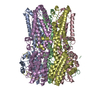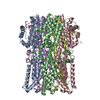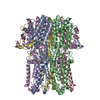+ Open data
Open data
- Basic information
Basic information
| Entry | Database: PDB / ID: 9dym | ||||||||||||||||||||||||
|---|---|---|---|---|---|---|---|---|---|---|---|---|---|---|---|---|---|---|---|---|---|---|---|---|---|
| Title | BEST1 + PABA intermediate state | ||||||||||||||||||||||||
 Components Components | Bestrophin-1 | ||||||||||||||||||||||||
 Keywords Keywords | MEMBRANE PROTEIN / calcium-activated chloride channel / para-aminobenzoic acid (PABA)-bound anion channel / channel-activator complex | ||||||||||||||||||||||||
| Function / homology |  Function and homology information Function and homology informationmembrane microdomain / bicarbonate channel activity / transepithelial chloride transport / gamma-aminobutyric acid secretion, neurotransmission / detection of light stimulus involved in visual perception / ligand-gated channel activity / intracellularly calcium-gated chloride channel activity / bicarbonate transmembrane transporter activity / glutamate secretion / chloride transport ...membrane microdomain / bicarbonate channel activity / transepithelial chloride transport / gamma-aminobutyric acid secretion, neurotransmission / detection of light stimulus involved in visual perception / ligand-gated channel activity / intracellularly calcium-gated chloride channel activity / bicarbonate transmembrane transporter activity / glutamate secretion / chloride transport / chloride channel activity / protein complex oligomerization / regulation of calcium ion transport / chloride channel complex / visual perception / basal plasma membrane / regulation of synaptic plasticity / Stimuli-sensing channels / presynapse / monoatomic ion transmembrane transport / basolateral plasma membrane / identical protein binding / membrane / plasma membrane / cytosol Similarity search - Function | ||||||||||||||||||||||||
| Biological species |  Homo sapiens (human) Homo sapiens (human) | ||||||||||||||||||||||||
| Method | ELECTRON MICROSCOPY / single particle reconstruction / cryo EM / Resolution: 2.67 Å | ||||||||||||||||||||||||
 Authors Authors | Owji, A.P. / Kittredge, A. / Zhang, Y. / Yang, T. | ||||||||||||||||||||||||
| Funding support |  United States, 7items United States, 7items
| ||||||||||||||||||||||||
 Citation Citation |  Journal: Nat Commun / Year: 2024 Journal: Nat Commun / Year: 2024Title: Neurotransmitter-bound bestrophin channel structures reveal small molecule drug targeting sites for disease treatment. Authors: Aaron P Owji / Jingyun Dong / Alec Kittredge / Jiali Wang / Yu Zhang / Tingting Yang /  Abstract: Best1 and Best2 are two members of the bestrophin family of anion channels critically involved in the prevention of retinal degeneration and maintenance of intraocular pressure, respectively. Here, ...Best1 and Best2 are two members of the bestrophin family of anion channels critically involved in the prevention of retinal degeneration and maintenance of intraocular pressure, respectively. Here, we solved glutamate- and γ-aminobutyric acid (GABA)-bound Best2 structures, which delineate an intracellular glutamate binding site and an extracellular GABA binding site on Best2, respectively, identified extracellular GABA as a permeable activator of Best2, and elucidated the co-regulation of Best2 by glutamate, GABA and glutamine synthetase in vivo. We further identified multiple small molecules as activators of the bestrophin channels. Extensive analyses were carried out for a potent activator, 4-aminobenzoic acid (PABA): PABA-bound Best1 and Best2 structures are solved and illustrate the same binding site as in GABA-bound Best2; PABA treatment rescues the functional deficiency of patient-derived Best1 mutations. Together, our results demonstrate the mechanism and potential of multiple small molecule candidates as clinically applicable drugs for bestrophin-associated diseases/conditions. | ||||||||||||||||||||||||
| History |
|
- Structure visualization
Structure visualization
| Structure viewer | Molecule:  Molmil Molmil Jmol/JSmol Jmol/JSmol |
|---|
- Downloads & links
Downloads & links
- Download
Download
| PDBx/mmCIF format |  9dym.cif.gz 9dym.cif.gz | 398.1 KB | Display |  PDBx/mmCIF format PDBx/mmCIF format |
|---|---|---|---|---|
| PDB format |  pdb9dym.ent.gz pdb9dym.ent.gz | 319 KB | Display |  PDB format PDB format |
| PDBx/mmJSON format |  9dym.json.gz 9dym.json.gz | Tree view |  PDBx/mmJSON format PDBx/mmJSON format | |
| Others |  Other downloads Other downloads |
-Validation report
| Arichive directory |  https://data.pdbj.org/pub/pdb/validation_reports/dy/9dym https://data.pdbj.org/pub/pdb/validation_reports/dy/9dym ftp://data.pdbj.org/pub/pdb/validation_reports/dy/9dym ftp://data.pdbj.org/pub/pdb/validation_reports/dy/9dym | HTTPS FTP |
|---|
-Related structure data
| Related structure data |  47309MC  9dyhC  9dyiC  9dyjC  9dykC  9dylC  9dynC  9dyoC M: map data used to model this data C: citing same article ( |
|---|---|
| Similar structure data | Similarity search - Function & homology  F&H Search F&H Search |
- Links
Links
- Assembly
Assembly
| Deposited unit | 
| |||||||||||||||||||||||||||||||||
|---|---|---|---|---|---|---|---|---|---|---|---|---|---|---|---|---|---|---|---|---|---|---|---|---|---|---|---|---|---|---|---|---|---|---|
| 1 |
| |||||||||||||||||||||||||||||||||
| Noncrystallographic symmetry (NCS) | NCS domain:
|
- Components
Components
| #1: Protein | Mass: 67760.469 Da / Num. of mol.: 5 Source method: isolated from a genetically manipulated source Source: (gene. exp.)  Homo sapiens (human) / Gene: BEST1, VMD2 / Cell line (production host): HEK293 / Production host: Homo sapiens (human) / Gene: BEST1, VMD2 / Cell line (production host): HEK293 / Production host:  Homo sapiens (human) / References: UniProt: O76090 Homo sapiens (human) / References: UniProt: O76090#2: Chemical | ChemComp-CA / #3: Chemical | #4: Chemical | #5: Water | ChemComp-HOH / | Has ligand of interest | Y | Has protein modification | N | |
|---|
-Experimental details
-Experiment
| Experiment | Method: ELECTRON MICROSCOPY |
|---|---|
| EM experiment | Aggregation state: PARTICLE / 3D reconstruction method: single particle reconstruction |
- Sample preparation
Sample preparation
| Component | Name: BEST1 + PABA intermediate state / Type: COMPLEX / Entity ID: #1 / Source: RECOMBINANT | ||||||||||||||||||||
|---|---|---|---|---|---|---|---|---|---|---|---|---|---|---|---|---|---|---|---|---|---|
| Molecular weight | Value: 0.338 MDa / Experimental value: NO | ||||||||||||||||||||
| Source (natural) | Organism:  Homo sapiens (human) Homo sapiens (human) | ||||||||||||||||||||
| Source (recombinant) | Organism:  Homo sapiens (human) / Cell: HEK293 Homo sapiens (human) / Cell: HEK293 | ||||||||||||||||||||
| Buffer solution | pH: 7.8 | ||||||||||||||||||||
| Buffer component |
| ||||||||||||||||||||
| Specimen | Conc.: 5 mg/ml / Embedding applied: NO / Shadowing applied: NO / Staining applied: NO / Vitrification applied: YES | ||||||||||||||||||||
| Specimen support | Grid type: UltrAuFoil R0./1 | ||||||||||||||||||||
| Vitrification | Instrument: FEI VITROBOT MARK IV / Cryogen name: ETHANE / Humidity: 100 % / Chamber temperature: 283 K |
- Electron microscopy imaging
Electron microscopy imaging
| Experimental equipment |  Model: Titan Krios / Image courtesy: FEI Company |
|---|---|
| Microscopy | Model: TFS KRIOS |
| Electron gun | Electron source:  FIELD EMISSION GUN / Accelerating voltage: 300 kV / Illumination mode: FLOOD BEAM FIELD EMISSION GUN / Accelerating voltage: 300 kV / Illumination mode: FLOOD BEAM |
| Electron lens | Mode: BRIGHT FIELD / Nominal magnification: 105000 X / Nominal defocus max: 1500 nm / Nominal defocus min: 800 nm / Cs: 2.7 mm / C2 aperture diameter: 100 µm / Alignment procedure: COMA FREE |
| Image recording | Electron dose: 58 e/Å2 / Film or detector model: GATAN K3 (6k x 4k) / Num. of grids imaged: 1 / Num. of real images: 1634 |
| EM imaging optics | Energyfilter slit width: 20 eV |
- Processing
Processing
| EM software |
| ||||||||||||||||||||||||||||||||||||||||||||||||||||||||||||||||||||||||||||||||||||||||||||||||||||||||||
|---|---|---|---|---|---|---|---|---|---|---|---|---|---|---|---|---|---|---|---|---|---|---|---|---|---|---|---|---|---|---|---|---|---|---|---|---|---|---|---|---|---|---|---|---|---|---|---|---|---|---|---|---|---|---|---|---|---|---|---|---|---|---|---|---|---|---|---|---|---|---|---|---|---|---|---|---|---|---|---|---|---|---|---|---|---|---|---|---|---|---|---|---|---|---|---|---|---|---|---|---|---|---|---|---|---|---|---|
| CTF correction | Type: PHASE FLIPPING AND AMPLITUDE CORRECTION | ||||||||||||||||||||||||||||||||||||||||||||||||||||||||||||||||||||||||||||||||||||||||||||||||||||||||||
| Particle selection | Num. of particles selected: 488010 | ||||||||||||||||||||||||||||||||||||||||||||||||||||||||||||||||||||||||||||||||||||||||||||||||||||||||||
| Symmetry | Point symmetry: C1 (asymmetric) | ||||||||||||||||||||||||||||||||||||||||||||||||||||||||||||||||||||||||||||||||||||||||||||||||||||||||||
| 3D reconstruction | Resolution: 2.67 Å / Resolution method: FSC 0.143 CUT-OFF / Num. of particles: 40311 / Symmetry type: POINT | ||||||||||||||||||||||||||||||||||||||||||||||||||||||||||||||||||||||||||||||||||||||||||||||||||||||||||
| Atomic model building | Protocol: RIGID BODY FIT | ||||||||||||||||||||||||||||||||||||||||||||||||||||||||||||||||||||||||||||||||||||||||||||||||||||||||||
| Atomic model building | PDB-ID: 8D1I Pdb chain-ID: A / Accession code: 8D1I / Source name: PDB / Type: experimental model | ||||||||||||||||||||||||||||||||||||||||||||||||||||||||||||||||||||||||||||||||||||||||||||||||||||||||||
| Refinement | Resolution: 2.67→2.67 Å / Cor.coef. Fo:Fc: 0.897 / SU B: 12.482 / SU ML: 0.222 / ESU R: 0.424 Stereochemistry target values: MAXIMUM LIKELIHOOD WITH PHASES Details: HYDROGENS HAVE BEEN ADDED IN THE RIDING POSITIONS
| ||||||||||||||||||||||||||||||||||||||||||||||||||||||||||||||||||||||||||||||||||||||||||||||||||||||||||
| Solvent computation | Solvent model: PARAMETERS FOR MASK CACLULATION | ||||||||||||||||||||||||||||||||||||||||||||||||||||||||||||||||||||||||||||||||||||||||||||||||||||||||||
| Displacement parameters | Biso mean: 57.808 Å2 | ||||||||||||||||||||||||||||||||||||||||||||||||||||||||||||||||||||||||||||||||||||||||||||||||||||||||||
| Refinement step | Cycle: 1 / Total: 15629 | ||||||||||||||||||||||||||||||||||||||||||||||||||||||||||||||||||||||||||||||||||||||||||||||||||||||||||
| Refine LS restraints |
|
 Movie
Movie Controller
Controller










 PDBj
PDBj






